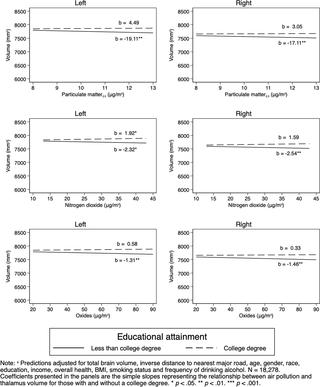PLOS ONE ( IF 2.9 ) Pub Date : 2020-03-30 , DOI: 10.1371/journal.pone.0230829 Dawson W Hedges 1, 2 , Lance D Erickson 3 , Shawn D Gale 1, 2 , Jacqueline E Anderson 2 , Bruce L Brown 1

|
Background
Air pollution has been associated with cognitive function and brain volume. While most previous research has examined the association between air pollution and brain volume in cortical structures or total brain volume, less research has investigated associations between exposure to air pollution and subcortical structures, including the thalamus. Further, the few available previous studies investigating associations between air pollution and thalamic volume have shown mixed results.
Methods
In this study, we evaluated the association between PM2.5, PM2.5–10, PM10, nitrogen dioxide, and nitrogen oxides and volume of the thalamus in adults using the UK Biobank resource, a large community-based sample, while adjusting for multiple covariates that could confound an association between air pollution and thalamic volume.
Results
In adjusted models, the left but not right thalamus volume was significantly inversely associated with PM2.5–10, although there were no significant associations between PM2.5, PM10, nitrogen dioxide, and nitrogen oxides with either left or right thalamic volumes. In addition, interactions between age and PM2.5–10 and PM10 were inversely associated with thalamic volume, such that thalamic volume in older people appeared more vulnerable to the adverse effects of PM2.5–10 and PM10, and interactions between educational attainment and PM2.5, nitrogen dioxide, and nitrogen oxides and between self-rated health and PM2.5–10 were positively associated with thalamic volume, such that higher educational attainment and better self-rated health appeared protective against the adverse effects of air pollution on the thalamus.
Conclusion
These findings suggest a possible association between thalamic volume and air pollution particularly in older people and in people with comparatively low educational attainment at levels of air pollution found in the United Kingdom.
中文翻译:

成人暴露于空气污染与丘脑容量之间的关联:一项横断面研究。
背景
空气污染与认知功能和大脑容量有关。尽管大多数先前的研究都研究了空气污染与大脑皮层结构或总大脑体积之间的关系,但很少有研究研究空气污染与皮质下结构(包括丘脑)之间的关系。此外,以前很少有调查空气污染与丘脑体积之间关系的研究显示出不同的结果。
方法
在这项研究中,我们使用UK Biobank资源(一个大型的社区样本)评估了成人中PM 2.5,PM 2.5-10,PM 10,PM 10,二氧化氮和氮氧化物与丘脑容量之间的关联,同时针对多个因素进行了调整可能混淆空气污染和丘脑体积之间关系的协变量。
结果
在调整后的模型中,左侧丘脑体积与右侧丘脑体积无关,而右侧丘脑体积与PM 2.5-10显着相反,尽管PM 2.5,PM 10,二氧化氮和氮氧化物与左侧丘脑体积或右侧丘脑体积之间无显着关联。此外,年龄与PM 2.5-10和PM 10之间的相互作用与丘脑容量成反比,因此老年人的丘脑容量似乎更容易受到PM 2.5-10和PM 10的不利影响,以及受教育程度与PM 10之间的相互作用。 PM 2.5,二氧化氮和氮氧化物以及自我评估的健康水平与PM 2.5-10之间 与丘脑容积呈正相关,因此较高的教育程度和较好的自我评估健康状况似乎可以防止空气污染对丘脑的不利影响。
结论
这些发现表明,在英国发现的丘脑体积与空气污染之间可能存在关联,尤其是在老年人和受教育程度相对较低的人中。










































 京公网安备 11010802027423号
京公网安备 11010802027423号